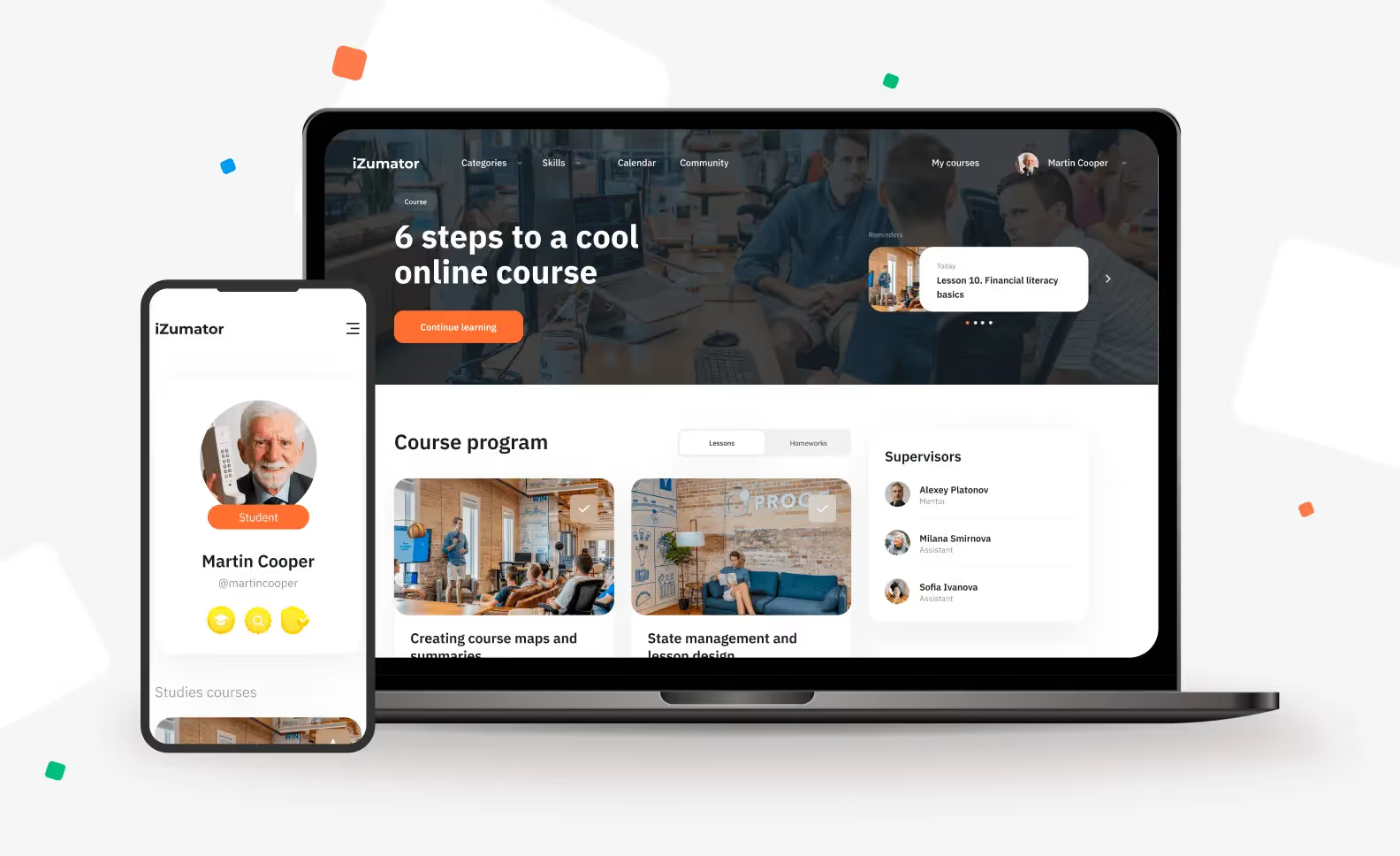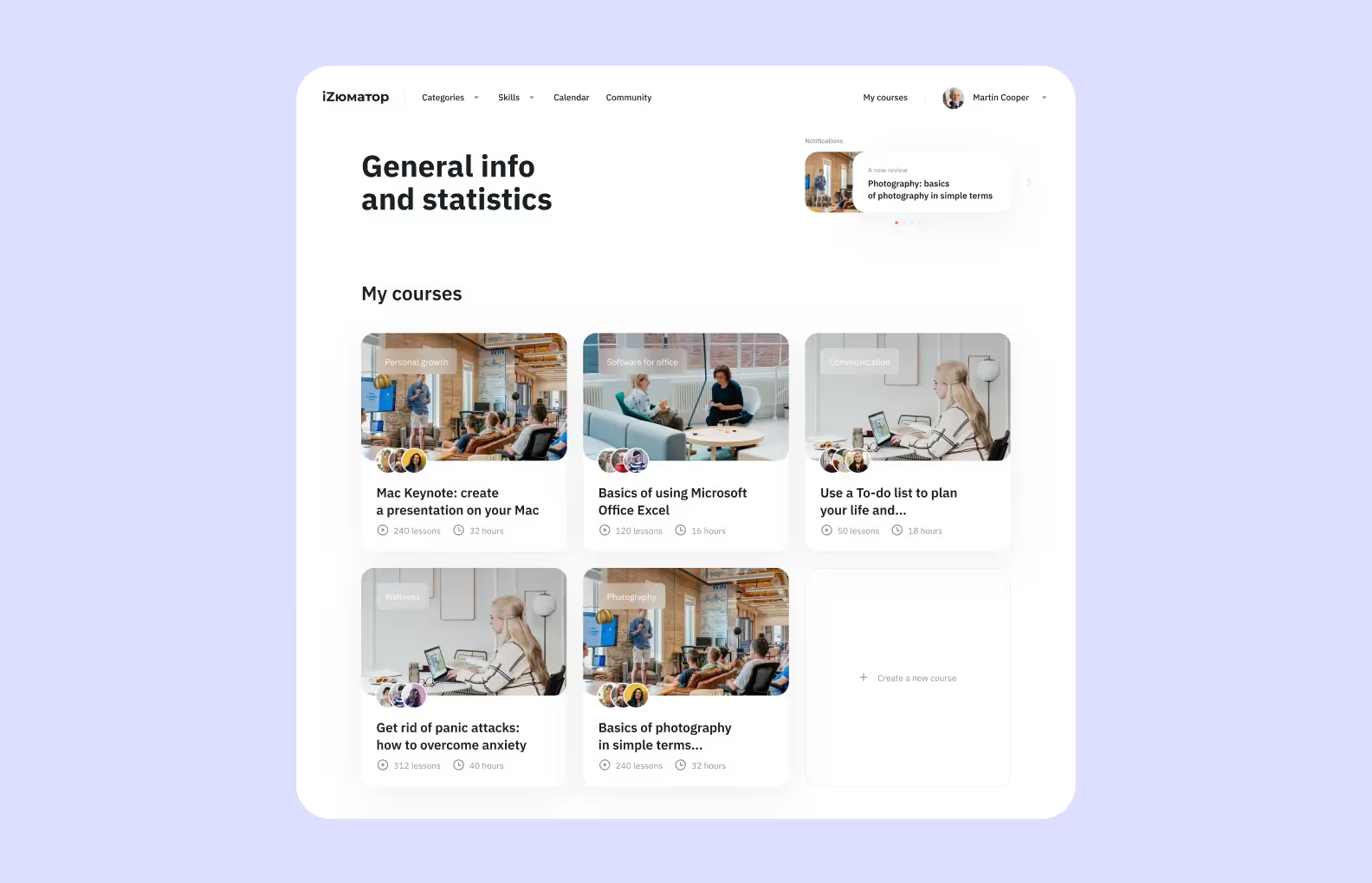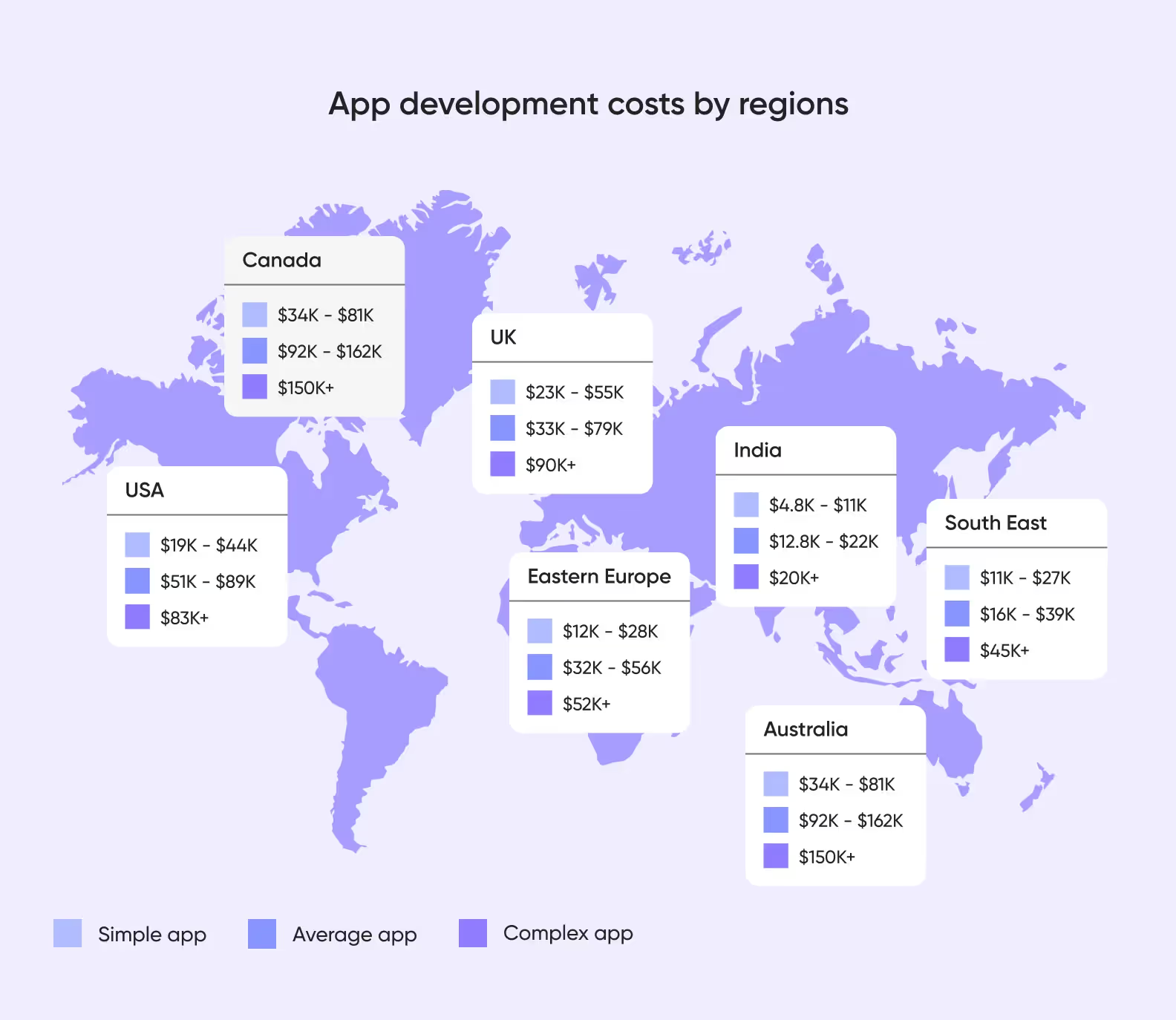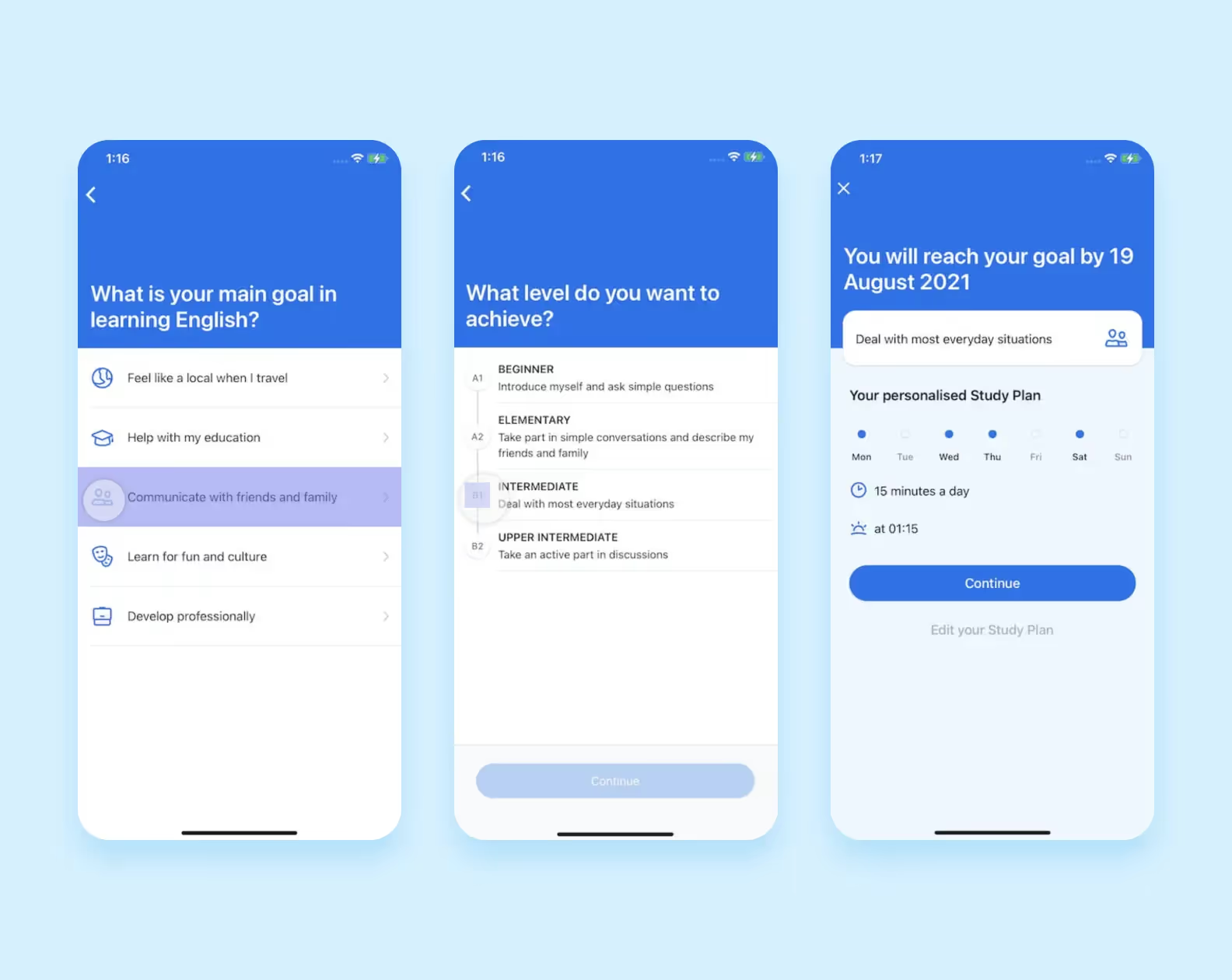


Educational apps ranked 4th on the list of the most popular Apple App Store categories. Business, utilities, and games are the only categories that outscore the learning apps, but the gap is not that big.
The target audience of educational apps is so wide — from kids and students to teachers and professors — that it becomes easy to find your own niche and monetize it.
In this article, we’ll explain how to create an educational app, explore its types and features. We’ll also break down the educational app development process and its cost.

Now, you need to choose the format that will be the most effective for an educational app. To do this, let’s go through the main types of education apps. Here are 7 of them.
Perfect for learners and students preparing for exams or looking for an efficient way to organize their knowledge. Some apps offer a set of expertly created flashcards, and some allow users to make their own. For example, Chegg Prep has millions of free flashcards and even covers narrow subjects like mitosis in biology.
Games can teach adults as well as kids. The education app Elevate makes memory and attention training fun, with lots of different puzzles and speed challenges.
Made for language learners, writers, and anyone looking to expand their vocabulary. Some dictionaries have additional features like the Merriam-Webster app with games and the word of the day.
Popular casual education apps for travelers and language enthusiasts that help to memorize words, practice writing or speaking, and more. There are education apps for one language (Chineasy) and for several languages (Memrise).
They're focused on niche needs, like mastering handwriting or coding. These apps can benefit educators, professionals, and parents. Many apps of this type cater to kids, like Otsimo, which helps children with autism to communicate better.
Mimicking exam structure, timing, and themes, these apps prepare students for SATs and other tests. For example, BARBRI provides materials and quizzes to train future lawyers for the bar exam.
Apps and services made by schools or universities for their students. These apps can have invite-based access and many functions: video lectures, assignments, profiles with grades, etc.
After choosing your educational app concept, the app-making process begins.
We have experience in educational app development. One example from our portfolio is the online education platform iZumator.
Our client initially requested a platform that he could use as an employee onboarding tool. However, their long-term goal was to enter the online education market and compete with other online learning platforms
We developed five user roles for the platform: student, mentor, assistant, admin, and supervisor. We also enabled users to switch between the roles. That would give people more flexibility: a student can become a mentor and vice versa.
We’ll use this case as an example to describe the educational app development.

Before starting the development process, we dive into your project to understand your goals and how we can help you achieve them.
If your mobile application or platform idea isn’t fully formed, that’s okay. During the consultation, we ask key questions to refine the product requirements.
We’ll also assess potential risks and outline strategies to address them. At the end of this process, we provide a detailed roadmap with an education app development estimate.
The estimate will include:
Stage costs: included in the project analysis costs
To make a competitive education app, you might want to add:
For iZumator, we implemented several key features: registration and personal profiles for five different roles, the ability to sign up for courses or create your own, a calendar, and video lessons.
But before adding every useful feature you can think of to your education app, it’s better to study what your potential audience needs. Project discovery is an effective way to do this.
Project discovery involves a thorough analysis of the market and user needs before development begins. This phase focuses on researching and gathering insights about the target audience and market demand.
The process helps determine if there's an audience for your product and provides valuable data on the potential revenue of the app.
We start by working out the internal logic of the educational app and creating a mindmap. Then transfer it to black and white wireframes. When the logic is coordinated, we determine the app’s style, then polish the details and create a UI-kit for fast and convenient mobile development.
The design of an education app should help students focus on their studies. In the case of iZumator, we created a clean white dashboard with subtle color accents to highlight the most important details of the course material.

We divide the entire education app development process into 2-week sprints. This allows us to keep our clients updated and quickly make changes. Below is a standard workflow of educational app development.
For reference, the development of an MVP usually takes us up to 3 months, and we can bring to life a project as complex as a streaming service in 10 months. Educational app development is somewhere in between, depending on the complexity of the project.
Thoroughly testing an education app is vital for delivering a smooth and safe user experience. Let’s have a closer look at the aspects to check before releasing the application.
Functionality. An educational app is filled with different tools for learning, such as quizzes, lessons, and videos. We make sure each tool works smoothly and as it’s supposed to.
App security. Comprehensive security testing is crucial to find any weak points that could be exploited by malicious users. This way, we ensure the data is safe and that we follow the rules about protecting users’ information.
Data management. Just imagine keeping your streak in Duolingo for over a year and then seeing that your progress is accidentally deleted because of some bugs in the application. Not everybody can get over such a trauma. That’s why we check that an educational app stores everything correctly and keeps your progress and information safe.
As you may see, testing an education app is a process that ensures users can enjoy learning without any problems. So, we use both manual and automated testing to provide high-quality software.
Stage costs: depend on duration and client’s needs
Firstly, we launch the application and make it available to users. Before this, we have to get approval from app stores and prepare the marketing materials, such as screenshots, description, and promoting videos.
Once people start using the application, we need to offer support for them. For example, provide FAQs and tutorials to guide them if they have any problems. You should also track their feedback to find and fix any issues quickly.
As education evolves, we add more subjects and courses to the app. The development team updates the app and adds new features on request to keep users interested. Besides, it’s better to regularly check security measures to protect their data and keep their trust.
Creating and supporting an educational app is an ongoing effort. We focus on helping users, making the application better, and keeping it safe.
When discussing educational applications, there are two key things to keep in mind.
Firstly, it has to be accessible. For instance, students should be able to use the app on any device.
Secondly, it must store a lot of learning data, so both teachers and students have plenty to choose from.
Considering this, there are two technologies we’d recommend employing for your educational application.
It’s a cross-platform framework which lets developers create an app for both Android and iOS, at the same time. React Native can saveup to 30% of your educational app development budget, by allowing the reuse of the code you already wrote. In case of educational applications, this allows you to reach more potential users, as you don’t have to settle for a single platform due to budget constraints.
The platform ensures proper scaling. Once you amass a certain number of users uploading study materials to your app, it may crash due to the sheer amount of data piling up in your database. PostgreSQL prevents this by easing the scaling process of your app’s database to accommodate the collected data, which makes it a great choice for e-learning app development.
Our development team specializes in React Native, but we can also use Flutter to develop educational apps. The table below shows 3 possible technology stacks and their approximate costs.
If you want to create an educational app for smartphones and the whole brand design with features that we’ve previously set, at our app development company the project will approximately cost $80 000. But that’s the case for an educational app.
Educational apps can be very different. The definitive educational app development costs and timeframes are different for each project. But if you're interested we can calculate it for you.
Complexity and number of features. The creation of features requires time and resources. That’s why MVPs and platforms with basic features cost less than advanced educational apps with 2+ roles, interactive lessons, quizzes, progress tracking, multimedia content, and social interaction.
Choice of tech stack and platforms. For example, each platform and device may require additional educational app development work, adding to the overall expenses. Still, there’s another way: startups often opt for cross-platform educational app development to reduce costs, as it’s 30% cheaper than developing a native application.
UI/UX design. A well-crafted, user-friendly interface promotes effective user interaction and increases user satisfaction, which influences the success of the app. However, developing intuitive and visually engaging UI/UX design requires resources and contributes to higher costs.
Integrations with external services. Each integration is a separate development module. Integrating analytics tools, payment systems, and cloud storage, for example, requires additional work, such as implementing APIs, processing errors, and conducting compatibility testing.
Location of the development team. Hourly rates for developers vary by region — the US, Europe, and Asia. For instance, hiring IT specialists from the United States or Canada can be expensive due to the high cost of living and salaries there. Meanwhile, Indian specialists are more affordable.

If you want to make an educational app, it’s important to keep up with the trends. Let’s use a language learning app as an example and explore educational apps’ trends and how they can be beneficial.
User engagement and retention are the key factors for any app or service. Thanks to game mechanics like levels, competition, or points, users have fun and stay motivated to keep learning. When you plan to make an educational app, think about gamification.
Some of the common gamification techniques are:
Web and mobile educational apps attract more and more people with different backgrounds and working hours. So a strict schedule and standard programs won’t work. To cater to more users, educational apps tend to make learning more flexible and personalized. So to build an educational app you don’t need to tie each lesson to a particular date: let users decide for themselves.
That kind of freedom is common for language learning apps as well. For English courses, Busuu allows users to choose the goal and the level at which the user currently is. At the end of the onboarding personalization, the app reveals when users will achieve their language goals.

To develop an educational app with a life-like learning process, video content is key. Seeing a teacher explaining a concept rather than reading about it is more engaging.
For language learning apps, video content can be used to showcase pronunciation or for other tutorials. In the Babbel app, experts share insights into the culture. For Spanish, the app offers a kitchen tour and a video explanation of food culture.
Here are some effective monetization approaches.
Offer a free version of your app with basic features and content, while premium features and exclusive content are available through in-app purchases or subscriptions. This allows users to experience the app’s value before committing to payments.
Provide users with options for monthly or annual subscriptions. Subscribers can access premium content, advanced features, and an ad-free experience.
Incorporate non-intrusive ads or sponsored content within your application. Ensure that ads don’t disrupt the learning experience and offer users the choice to remove ads through a one-time purchase or subscription.
Remember that the success of your monetization strategy hinges on striking a balance between generating revenue and delivering value to your users.
It seems like a great idea to invest in educational mobile app development, and the latest stats prove it. Online education isn’t just a fancy trend that will disappear in a few years. It’s a new form of learning that can bring revenue through the app’s monetization with subscription plans or in-app purchases.
It’s easy to make education mobile apps with a professional development team. You just need to create a business plan, determining your ambitions and available resources. After the project evaluation, the team will take over developing a design concept, the app itself, testing its quality, and maintenance if needed.
Start with the development of an MVP — it’s an industry-standard practice that helps to test the idea. Both big companies and small startups can benefit from this approach.
➡️ The realization of your idea is just a click away. <a class="blog-modal_opener">Fill the form</a>, and Purrweb’s expertise will be at your service!